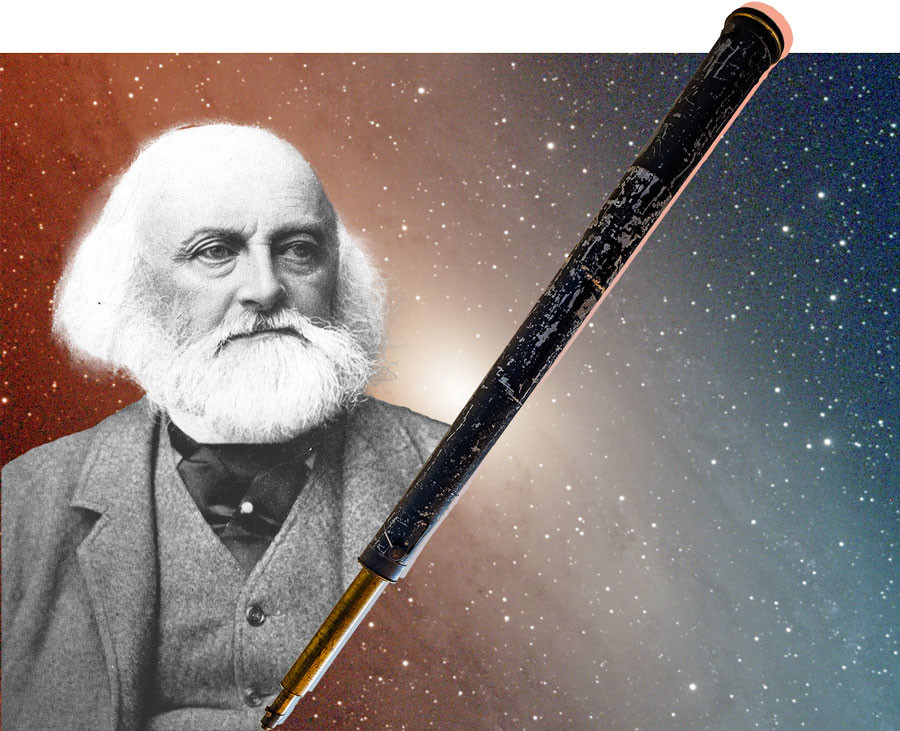One day in 2004, John Briggs, an astronomer and antique-telescope collector in New Mexico, got a call from his friend Joe Patterson, a professor of astronomy at Columbia. The two had met in the early 1970s in the Mojave Desert, where Briggs attended an astronomy camp for teenagers that Patterson, a grad student at the time, had founded. (Briggs’s bunkmate in the summer of 1973 was another young stargazer named Neil deGrasse Tyson ’92GSAS.) Now Patterson informed Briggs that a telescope built by Lewis Morris Rutherfurd 1887HON, which the University had loaned out to the Smithsonian Institution years earlier, had been returned to Columbia in a giant crate. There was no room for it in Pupin Hall or anywhere else, and the astronomy department was seeking a worthy custodian for the artifact. And so Patterson asked his former camper if he would like to add the Rutherfurd telescope to his collection.
“I was like, ‘Uh … yes,’” says Briggs, a friendly, voluble encyclopedia of telescopic lore. “I had never seen it, but I sure as hell knew about it and about Rutherfurd and his scientific accomplishments.”
In 1856, when the night skies of Manhattan appeared much starrier than they do today, Lewis Rutherfurd, a wealthy lawyer whose great-grandfather, Lewis Morris, had signed the Declaration of Independence, constructed, in the garden of his house at East 11th Street and Second Avenue, the largest private observatory in America. Two years later, the amateur astronomer and telescope builder became a Columbia trustee and began work on his masterpiece: a telescope with a thirteen-inch lens and an eyepiece that he ingeniously rigged with a camera, creating, essentially, a huge telephoto lens.
Soon after, Rutherfurd, who had practiced law with Peter Jay 1794CC and Hamilton Fish 1827CC, turned his attention away from jurisprudence and toward lenses, plates, emulsions, measuring devices, and the higher math of astrophysics. For twenty years he trained his telescopes on the moon, sun, planets, and stars, producing hundreds of startlingly revelatory images, including his famous 1865 photograph titled The Moon, New York.
“Rutherfurd was among the best astrophotographers of his day,” says Briggs. “And this particular telescope, which was his largest and greatest, was the first to photograph the solar granulation, which covers the sun’s surface.”
Rutherfurd also pioneered astronomical spectroscopy, which measures the spectrum of electromagnetic radiation emanating from stars — the key to identifying their physical properties — and was among the first to publish a classification of the different patterns of light observed in different stars.
That a self-taught backyard astronomer should achieve such scientific heights rankled his formally trained contemporaries. “He must be recognized as the father of celestial photography,” wrote the astronomer Benjamin Gould, a friend of Rutherfurd’s, “and in spite of the cold indifference with which his first achievements were regarded by most astronomers, he kept steadily to his mission with an unostentatious disregard of obstacles until he saw it crowned with full success.”
Failing health caused Rutherfurd to abandon his work, and he made his last prints in 1877. In 1884 he donated his instruments and hundreds of photographic plates to Columbia. After Pupin Hall, the new home of the astronomy department, was completed in 1927, the rooftop observatory was eventually named for Rutherfurd. Today, Rutherfurd’s revolutionary telescope resides in a converted gymnasium in Magdalena, New Mexico, that houses Briggs’s collection of antique telescopes. It’s the crown jewel of what Briggs calls his Astronomical Lyceum.
Rutherfurd died in 1892 at the family estate outside Hackettstown, New Jersey, called Tranquility. The celestial-minded will recognize that it shares its name with the site on the moon where, in 1969, astronauts Neil Armstrong and Buzz Aldrin stepped foot (“Houston, Tranquility Base here — the Eagle has landed”). Some might say it’s a coincidence, but others see it as proof that for Lewis Morris Rutherfurd — and his telescope — the stars had a way of aligning.



